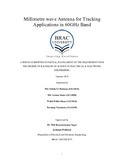| dc.contributor.advisor | Sagor, Dr. Md. Hasanuzzaman | |
| dc.contributor.author | Rahman, Md. Fahim Ur | |
| dc.contributor.author | Islam, Md. Sumon | |
| dc.contributor.author | Khan, Walid Uddin | |
| dc.contributor.author | Yeashmin, Purnima | |
| dc.date.accessioned | 2018-11-15T06:47:35Z | |
| dc.date.available | 2018-11-15T06:47:35Z | |
| dc.date.copyright | 2018 | |
| dc.date.issued | 2018-08-01 | |
| dc.identifier.other | ID 14121016 | |
| dc.identifier.other | ID 14121088 | |
| dc.identifier.other | ID 13221026 | |
| dc.identifier.other | ID 13221049 | |
| dc.identifier.uri | http://hdl.handle.net/10361/10856 | |
| dc.description | This thesis is submitted in partial fulfilment of the requirements for the degree of Bachelor of Science in Electrical and Electronic Engineering, 2018. | en_US |
| dc.description | Catalogued from PDF version of thesis. | |
| dc.description | Includes bibliographical references (page 86-90). | |
| dc.description.abstract | In this thesis, the design, fabrication, and characterization of a 2 x 8 corporate feed antenna
array operating at the 60 GHz band for applications of directional purposes like automated
vehicle. To design our desired antenna, we are using Microstrip Patches with feed line and we
are working on CST. We are creating an array by square patches with one feed line. To design
array we considered about array spacing, impedance matching, length and width of feed line
with most importance. We have implemented 2 x 8 element array. We had proceeded step by
step by designing and analysing of single patch, 4 element array and 8 element array. Then we
implement our proposed design and got the desired result. In all those designs we use
Roger5880 substrate. We used square patches in our design and we feed them with quarter
wave transformer. All the transmission line bands are 90 degree bands in our design. The array
pattern is symmetry of our proposed design. We match our whole design with 50-ohm feedline
where input impedance is 86.1-ohm. The main purpose of this thesis is to reduce the
complexity of making antenna array of higher number of element. We got our desired result at
59.76 GHz which is in unlicensed band (57-64 GHz) and has a maximum realized directivity
is 14.3 dB. The bandwidth is roughly 4.2 GHz, with 61.9 GHz the high end and 57.7 GHz the
low end of the frequency band. The antenna design will be fabricated later. | en_US |
| dc.description.statementofresponsibility | Md. Fahim Ur Rahman | |
| dc.description.statementofresponsibility | Md. Sumon Islam | |
| dc.description.statementofresponsibility | Walid Uddin Khan | |
| dc.description.statementofresponsibility | Purnima Yeashmin | |
| dc.format.extent | 90 pages | |
| dc.language.iso | en | en_US |
| dc.publisher | BRAC University | en_US |
| dc.rights | BRAC University theses are protected by copyright. They may be viewed from this source for any purpose, but reproduction or distribution in any format is prohibited without written permission. | |
| dc.subject | Wave antenna | en_US |
| dc.subject | Tracking applications | en_US |
| dc.subject.lcsh | Computer networks. | |
| dc.subject.lcsh | Antennas (Electronics) | |
| dc.title | Millimetre wave antenna for tracking applications in 60GHz band | en_US |
| dc.type | Thesis | en_US |
| dc.contributor.department | Department of Electrical and Electronic Engineering, BRAC University | |
| dc.description.degree | B. Electrical and Electronic Engineering | |

